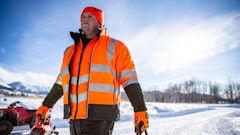
Those in the construction industry are responsible for building the places where our lives unfold: Our homes, offices, communities, and infrastructure. The industry plays a crucial role in maintaining and building our societies. Ranked fourth on the Occupational Safety and Health Administration (OSHA) list of most dangerous jobs, construction also happens to be one of the most dangerous career paths out there – with slips, trips, and falls cited as one of the largest threats for those in the industry.
In 2021, the construction industry accounted for 46.2% of all fatal falls, slips, and trips[3]. In fact, falls in particular are a rising problem in construction according to the most-recent publicly available data with a 50% increase in the number reported over the past decade.
Understanding the Dangers
The biggest danger associated with commonplace construction industry accidents like slips, trips, and falls are traumatic brain injuries (TBIs): Falls, in particular, lead to nearly half of all TBI hospitalizations[5]. Depending on the severity of the impact sustained, TBIs can lead to time away from work, permanent disabilities, or even death. However, a survey by Nielsen and commissioned by global leader in helmet-based safety, Mips, found that a vast majority of American helmet purchasers don’t understand one of the biggest causes of TBIs: Rotational Motion.
Rotational motion is a common cause for concussions and more severe brain injuries in oblique hits to the head. In most instances when you fall and hit your head or when a falling object glances the head, the impact occurs at an angle. For example, you trip over stray equipment on a jobsite and hit your head: The impact to your head would probably occur at an angle. This angled impact can expose your head to rotational motion, which can lead to shearing of the brain’s axons, the cable transmitters of neurons, and can cause TBIs. TBIs can lead to severe injuries, time away from work, and even fatalities[7]. Decades of research has proven that, when it comes to TBIs, the brain is more sensitive to rotational motion than linear motion (which is primarily caused by straight impacts to the top of the head). In fact, when rotational motion is involved, even impacts that were considered light have the potential to cause TBIs, due to the brain’s sensitivity[8]. Traumatic Brain Injuries are responsible for 25% of all construction fatalities, and even more life-altering injuries.
What Can Be Done?
While OSHA requires hard hats and head protection be worn by workers at risk of head injuries on the job, there are currently no construction helmet mandates that take rotational motion into account. So, while a step in the right direction, requiring that head protection Personal Protective Equipment (PPE) be worn on job sites does little to address the risk presented by rotational motion. In fact, the aforementioned Nielson / Mips survey found that seven out of 10 American helmet buyers do not even consider rotational motion when buying a helmet.
Safety systems with the aim of reducing the effects of rotational motion on the brain can be integrated within helmets, allowing material in the helmet to slide and move relative to the wearer’s head. The intended outcome is to redirect rotational motion away from the head, and consequently help reduce the amount of rotational motion that could otherwise be transferred to the brain which could result in a TBI. These systems are informed by a vast body of ever-growing scientific research and are designed to help reduce the rotational motion of certain impacts.
For helmet wearers, whether your helmet is equipped with a safety system that can address rotational motion is an important consideration.
 The biggest danger associated with commonplace construction industry accidents like slips, trips, and falls are traumatic brain injuries.Mips
The biggest danger associated with commonplace construction industry accidents like slips, trips, and falls are traumatic brain injuries.Mips
Despite the Dangers, Workers Often Don’t Comply With THIS Proper Safety Measure
Whether or not a helmet is equipped with a safety system that addresses rotational motion has little impact if the helmet is not being properly worn: Chinstraps can play a crucial role in safety, but compliance with properly wearing them has historically been a thorn in the construction industry’s side.
Chinstraps can help keep a helmet on your head in case of a slip, trip, or fall: Securing the helmet to the head is crucial to ensure the helmet actually provides the wearer with protection. Only when a helmet is on the head can it provide any sort of risk reduction against TBIs and other types of head injuries in case of accidents. When worn properly, a safety helmet should fit snugly, but comfortably, with the chinstrap securely buckled.
Despite chinstraps’ importance in allowing helmets to properly function, getting people to properly comply with safety measures has historically been a challenge. This challenge is emblematic of a long American history with resisting public safety measures – including with seatbelts.
The construction industry must find a balance between safety and individual autonomy: Proper education about the risks of rotational motion, TBIs, and the simple steps to help reduce the risks they pose is an important starting point to allow those in the industry to make informed decisions towards their well-being.
Decades of research has proven that, when it comes to TBIs, the brain is more sensitive to rotational motion than linear motion (which is primarily caused by straight impacts to the top of the head). In fact, when rotational motion is involved, even impacts that were considered light have the potential to cause TBIs, due to the brain’s sensitivity. Traumatic Brain Injuries are responsible for 25% of all construction fatalities, and even more life-altering injuries.
Despite chinstraps’ importance in allowing helmets to properly function, getting people to properly comply with safety measures has historically been a challenge. This challenge is emblematic of a long American history with resisting public safety measures – including with seatbelts.
The construction industry must find a balance between safety and individual autonomy: Proper education about the risks of rotational motion, TBIs, and the simple steps to help reduce the risks they pose is an important starting point to allow those in the industry to make informed decisions towards their wellbeing.
What Can Be Done?
While OSHA requires hard hats and head protection be worn by workers at risk of head injuries on the job, there are currently no construction helmet mandates that take rotational motion into account. So, while a step in the right direction, requiring that head protection Personal Protective Equipment (PPE) be worn on job sites does little to address the risk presented by rotational motion. In fact, the aforementioned Nielson / Mips survey found that seven out of 10 American helmet buyers do not even consider rotational motion when buying a helmet.
Safety systems with the aim of reducing the effects of rotational motion on the brain can be integrated within helmets, allowing material in the helmet to slide and move relative to the wearer’s head. The intended outcome is to redirect rotational motion away from the head, and consequently help reduce the amount of rotational motion that could otherwise be transferred to the brain which could result in a TBI. These systems are informed by a vast body of ever-growing scientific research and are designed to help reduce the rotational motion of certain impacts.
For helmet wearers, whether your helmet is equipped with a safety system that can address rotational motion is an important consideration.
Workers Often Don’t Comply With This Proper Safety Measure
Whether or not a helmet is equipped with a safety system that addresses rotational motion has little impact if the helmet is not being properly worn: Chinstraps can play a crucial role in safety, but compliance with properly wearing them has historically been a thorn in the construction industry’s side.
Chinstraps can help keep a helmet on your head in case of a slip, trip, or fall: Securing the helmet to the head is crucial to ensure the helmet actually provides the wearer with protection. Only when a helmet is on the head can it provide any sort of risk reduction against TBIs and other types of head injuries in case of accidents. When worn properly, a safety helmet should fit snugly, but comfortably, with the chinstrap securely buckled.


















